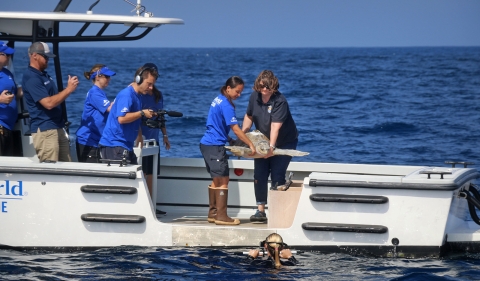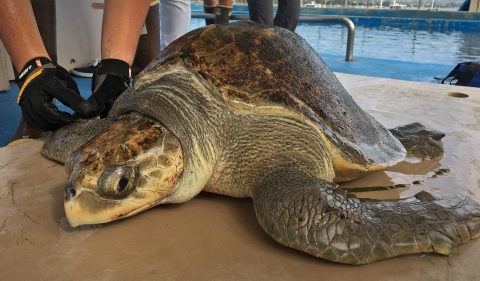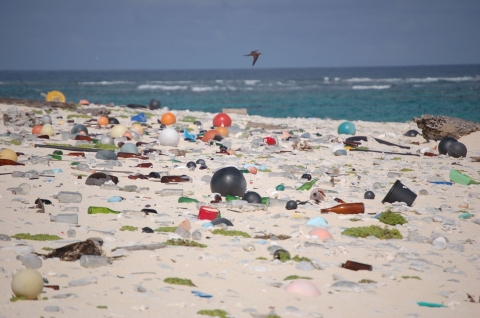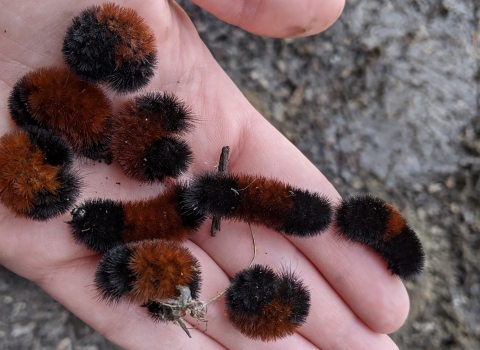Sea turtles wash up on Oregon beaches and many people find them stranded and want to help.
Question: Why do turtles come all the way to the Pacific NW if they are warm-water turtles? Did it take a wrong turn?
Answer: Many species of sea turtles occur throughout the Pacific Ocean, including the relatively cold waters of Oregon and Washington coasts. Some sea turtles even occur in Alaska! Our coastal waters are highly productive and provide excellent food resources. However, sea turtles typically do not occur on our beaches unless they are seriously sick or injured.
We really do not know why turtles become stranded, and research is ongoing to try to determine the causes. However, there are several conditions common to stranded turtles in Oregon. Generally, stranded turtles have become “hypothermic” or “cold-stunned” and cannot function normally. Other illness or injury often leads to the turtle being stressed and unable to effectively respond to cold and return to warmer waters. Entanglement in fishing gear and marine debris, motorboat collisions, or ingestion of non-food items such as plastic bags that resemble jelly fish (a turtle favorite), can all lead to injury and stress that can eventually cause stranding.
Strandings are often seen in late fall and early winter during a time when ocean conditions are transitioning, possibly trapping turtles in colder waters. Severe storms and weather conditions such as El Niños can cause turtles to be displaced northward by current and the search for food. The turtles can get trapped in cold waters with these events. As cold waters reduce body temperatures, they become less able to swim and feed and more susceptible to ocean and wind currents, which can eventually lead to stranding.
Question: Are rescued turtles kept in captivity or returned to ocean?
Answer: Stranded turtles are taken to an authorized rehabilitation facility where they are treated for hypothermia and assessed for underlying illness or injury. Since sea turtles are protected under the Endangered Species Act, rehabilitation facilities must be permitted by the Service, have appropriate facilities and experience, and provide appropriate specialized care to treat the animals. Once treated and deemed healthy enough for transport, the turtle is returned to southern waters where it is released. If the turtle is unfit to return to the wild, it would be assessed to determine if it should be maintained in captivity at an approved facility or euthanized to minimize further suffering. So far, all turtles that have survived hypothermic conditions in Oregon and Washington have been returned to the wild within a few months of stranding.
Question: How can a reptile be hypothermic?
Answer: Sea turtles are cold-blooded reptiles, so their body temperatures vary with their environment. They have some physical or behavioral adaptations such as their large body size, dark coloration, and constant swimming movements to maintain a suitable body temperature. If they are unable to keep an adequate body temperature, often due to injury or illness, they can lose their ability to navigate and swim properly and wash up on beaches.
Question: Aren’t the turtles beaching themselves to warm up?
Answer: Sea turtle basking (sun-bathing) is extremely rare and only known to occur on beaches in very warm climates such as Hawaii. Movement on land is difficult for such large creatures, exposure to potential predators is much greater, and air temperature can vary considerably more than water temperatures. In Oregon, the cool coastal air is generally not warm enough to warm a turtle. Alternatively, on very warm days, beached sea turtles can heat too quickly in direct sun, and in a weakened state, a turtle can rapidly succumb to dehydration and overheating.
Question: What should you do if you find a turtle or other sea animal stranded in an unnatural situation?
Answer: Call the authorities in the area. In Oregon, the Oregon State Police, Wildlife Division can be reached at
1-800-452-7888 or the Marine Mammal Stranding Network at 1-866-767-6114. In Washington, call the Marine Mammal Stranding Network at 1-866-767-6114.
Important points to keep in mind:
- Sea turtles are listed and protected under the U.S. Endangered Species Act and wildlife laws of Oregon and Washington. All sea turtles, both dead and alive, are legally protected.
- Callers should be prepared to tell exactly where the turtle is located, whether it appears to be dead or alive, and the size of the animal (estimated weight or length of shell – to know if one person can lift it, or will require two or more persons to respond). If possible, stay near the animal to help orient officials and protect the turtle from scavengers.
- Due to the considerable travel distances that may be involved, and the possibility that another turtle stranding could occur at the same time, response can be delayed. Please be patient.
- Due to safety considerations, personnel may not travel at night to isolated unfamiliar areas.
Question: What can I do to help sea turtle conservation?
Answer: Obviously, if you see a stranded turtle call the numbers above, but one of the most important things we can do for sea turtles is conserve our oceans. Here are some great resources to learn more about ocean conservation:
- National Geographic: 10 Things You Can Do to Save the Ocean
- Smithsonian: How You Can Help the Ocean
- Story - Oceans of Trash
Many communities have local beach clean-up events. Check your local area for opportunities to volunteer.








